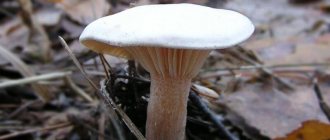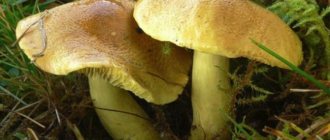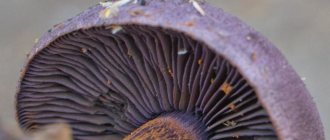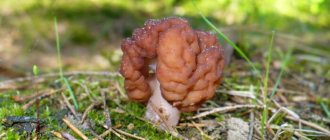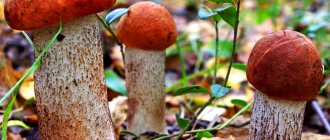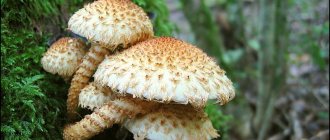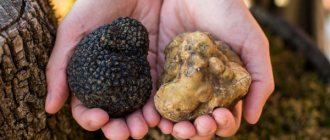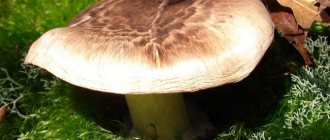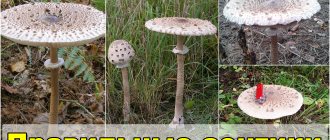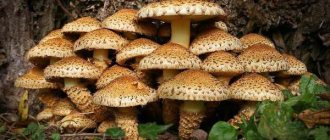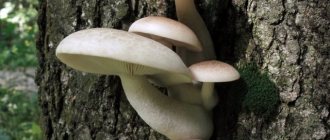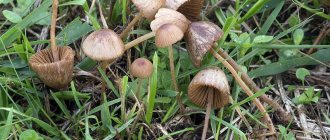Peziza varia is an interesting lamellar mushroom that is part of the genus and family Peziza varia. It belongs to the class of discomycetes, marsupial fungi and is a relative of stitches and morels. Previously, mycologists distinguished it as a separate species. Recent studies at the molecular level have proven that the species of pecia, which were considered separate, can be classified as one large genus.
Petsitsa
The mushroom mushroom does not have a cap as such; it has a sessile fruiting body.
In a young mushroom it has a bubble shape, then, with age, it opens, and in old age it takes on the shape of a saucer with the edges slightly turned up. It can reach from four to ten centimeters in diameter. The surface is brown, smooth, and shiny in wet weather. The outer surface is brown and slightly grainy. The pulp of this mushroom is thin, brittle, and has no special taste or smell. White spore powder.
This mushroom can be found in forests of absolutely any type, on dead trees, rotten wood and on the soil, from mid-May to early autumn. Some sources may classify this mushroom as edible, but both in appearance and in quality, this mushroom does not inspire confidence, so most authors classify it as an inedible type of mushroom.
Synonyms
In 2002, based on the results of morphological and molecular studies, mycologists Hansen, Lesso and Pfister concluded that the boundaries between the species of Peziza varia
,
P. cerea
,
P. repanda
and
P. micropus
are very vague and undetectable, which prompted them to combine these four species into one polymorphic one under the earliest name -
Peziza varia
. Despite this, the other three names are still often used in literature.
- Aleuria cerea (Sowerby) Gillet, 1881
- Aleuria micropus (Pers.) Gillet, 1881
- Aleuria repanda (Pers.) Gillet, 1881
- Aleuria varia (Hedw.) Boud., 1905
- Discina repanda (Pers.) Sacc., 1889
- Galactinia cerea (Sowerby) Le Gal, 1962
- Galactinia micropus (Pers.) Svrček, 1962
- Galactinia repanda (Pers.) Le Gal, 1962
- Galactinia varia (Hedw.) Le Gal, 1962
- Galactinia vesiculosa f. cerea (Sowerby) Svrček, 1961
- Geopyxis micropus (Pers.) Rehm, 1894
- Geopyxis varia (Hedw.) Rehm, 1894
- Humaria varia (Hedw.) Sacc., 1889
- Macroscyphus cereus (Sowerby) Gray, 1821
- Octospora varia Hedw., 1789basionym
- Otidea micropus (Pers.) Sacc., 1889
- Peziza cerea Sowerby, 1797
- Peziza micropus Pers., 1800
- Peziza repanda Pers., 1808
- Plicaria micropus (Pers.) Banhegyi, 1939
- Plicaria repanda (Pers.) Rehm, 1894
- Pustularia cerea (Sowerby) Rehm, 1881
Purple dog
10 Best Resources on the Topic: Spitz Mushroom
Pictures upon request Pesica mushroom - edible
Orange pixie mushroom, edible tree mushrooms, photos and...
Edible mushroom
orange (Aleuria aurantia) spreads in coniferous and mixed types of forests, quite often you can find it...
Encyclopedia of Mushrooms > Edible Mushrooms
Albatrellus confluens Albatrellus confluens is an annual edible mushroom.
. Basodiomas have a central...
Encyclopedia of Mushrooms > Pecica
Petsitsa
variable (Peziza varia) Fruiting body: in young
mushrooms
it has the shape of a hemisphere, cup-shaped.
... Headings: P, Conditionally edible mushrooms
.Edible mushrooms - names, catalog
Names and descriptions of popular edible mushrooms
, catalog at ya-gribnik.ru.
... Petsitsa
.
White steppe mushroom
.
Pluteus deer. Caesar mushroom
.The Complete Encyclopedia of Mushrooms - Result from Google Books
https://books.google.ru/books?isbn=5386005790
Tatyana Vladimirovna Lagutina — 2013 — Nature
Mushroom cap
convex, but over time it straightens out and becomes...
loach
is
an edible mushroom
, in some...Mushrooms - Result from Google Books
https://books.google.ru/books?isbn=5458272226
I.A. Dudka — — Science
Little-known edible mushroom
.
Petsitsa
notched
Petsitsa
viTmchata Re212a herapda Regs. : Rg. Fruiting bodies are 2-10 cm in diameter, solitary or...Rare but edible mushrooms
23 Jan 2013 …
As a rule, people cut only those
mushrooms
that they are confident in.
... The next no less edible mushroom
is
beetroot
.Mushrooms. Edible and Inedible: The Most Complete and Up-to-Date... - Result from Google Books
https://books.google.ru/books?isbn=5457446247
A. Polenov — 2014 — Nature
… tesselatum) 112 Sheep mushroom
(Albatrellus ovinus) 116 Deer
mushroom
(Pluteus ... 40 Pepper
mushroom
(Chalciporus piperatus) 108
beetle mushroom
(Peziza ...
Where and how does it grow
The variable petitsa loves rotten, half-rotten wood, soils saturated with forest waste, or old fires. The mycelium begins to bear fruit in the spring, when the weather is quite warm and the snow melts, it even received the name snowdrop mushroom. They continue to grow until October frosts, and in the southern regions even until persistent frosts.
It is found quite often, in small, closely planted groups, in forests, gardens and parks. Distributed in the Krasnodar region and throughout Russia. It can also be seen throughout Europe and North America.
“The Motley Hooligan,” or Magpies Beginning to Robbery
Magpies are famous robbers. They are not considered social birds. Konrad Lorenz compares them to a hardened criminal in a civilized human society. He notes that they do not have the kind of restraining regulators that are so attractive in the behavior of jackdaws.
The stable phrase “thief magpie” is due to the fact that magpies actually drag a variety of objects towards them. Some (threads, pieces of fabric) are for use in nest construction. Others are for fun. Those people who had magpies living in their houses noted that magpies more often steal items that people use (glasses, watches, cosmetics, buttons, etc.).
Darrell's family had more than once conflicts with the Magpies who carried out the robbery.
Description
Petsitsa is the scientific name for mushrooms. People call them differently. There are mushrooms that appear in our spring forests - these are the famous strings and morels, and besides them, amazing orange mushrooms appear along forest paths and on the edges, and just in the moss. Bright little mushrooms are very bowl-like, and with age they become flatter, similar to ordinary saucers or plates, which gives them the name saucers.
These mushrooms are related to strings and morels, and although they mainly grow on the ground, quite often they, like strings, grow on the sites of former fires and even cover fire sites with their colonies. And the bladderwrack very often chooses gardens and greenhouses as its habitat. These mushrooms have a very diverse coloring. Brown beetles, which grow in moist forest soil, are inedible mushrooms. But the orange arctic dog, the most attractive, looks like orange slices, which very often attracts mushroom pickers.
Beneficial features
These bright, beautiful mushrooms perfectly help the body, weakened after winter, strengthen the immune system and recover after the season of colds and other seasonal diseases. One of the amazing properties of the dog is considered to be the ability not only to help with various eye diseases, especially with developing age-related farsightedness, but also to influence weak eye muscles and speed up metabolic processes.
Due to their high content of vitamin C, which increases the body's resistance, mushrooms should be consumed during outbreaks of viral diseases. In addition, petsitsa can be used for various inflammations and even remove harmful toxins from the body of cancer patients who have undergone chemotherapy, and residents of large cities suffering from environmental pollution.
Use in cooking
Petsitsa is considered an edible mushroom, and differs from most mushrooms in the complete absence of any taste and almost complete absence of smell. They can be boiled and fried, added to salads and stews, but with this method of cooking, the mushrooms lose their amazing color. Pitsitsa looks very beautiful when salted, adding brightness to the assorted mushrooms, and pickled mushrooms completely retain their color. Quite often, chefs use pezitsa to decorate various dishes, especially salads; they look very beautiful, aesthetically enrich dishes, turning them into culinary masterpieces. Dried mushrooms are made into a powder and added to sauces and seasonings to give them their orange color.
The benefits of pizzeria and treatment
Petsitsa promotes blood thinning, this is especially valuable for patients with thrombophlebitis and varicose veins. For those who suffer from seasickness and cannot stay in transport for a long time due to motion sickness, you can try taking tincture of pizzeria.
Harm to the pepper and contraindications
The dog brings harm if, instead of the edible orange one, a brown dog that is considered inedible ends up in the mushroom picker's basket, and then there is a high risk of poisoning. In addition, mushrooms absorb harmful substances from the environment and should not be collected near roads.
Application
This species is often used in folk medicine. Medicines for joints and cleansing the body of helminths are prepared from it.
Also used in cooking. The horns are especially suitable for pickling and drying. They make delicious soups and mushroom caviar.
In cooking
Fresh deer horns are washed, cut into small pieces and boiled.
This species also makes delicious sauces and baking fillings. The taste of ready-made deer antlers is similar to seafood or boiled chicken. For mushroom salad take:
- boiled mushrooms – 150 g;
- carrots – 150 g;
- small onion;
- vinegar – 2 tbsp;
- sunflower oil – 1 tbsp;
- garlic – 2 cloves;
- salt, pepper, herbs to taste.
Finely chopped mushrooms are combined with carrots and garlic. Then salt, add pepper and herbs, season with vegetable oil, and let it brew for 30 minutes. At this time, the onion is cut into rings, marinated and mixed with salad.
Marinated deer horns have a particularly delicate taste. To prepare them you need to take: lemon juice, apple cider vinegar, black pepper and vegetable oil. In appearance, pickled horns resemble corals.
First course recipe:
- mushrooms – 400 g;
- carrots – 150 g;
- potatoes – 400 g;
- cheese – 150 g;
- butter – 50 g;
- salt, pepper, herbs.
Boil the mushrooms for 30 minutes, cut into small pieces. Vegetables are also chopped and thrown into the pan.
Add mushrooms, salt, pepper and herbs to the boiled vegetables and leave on low heat for 15 minutes. Then add grated cheese and butter; if desired, add cream or sour cream sauce before use.
In medicine
Description of the recipe for a medicine with a mushroom to combat stomach ulcers:
- 150 g of fresh mushrooms are thoroughly washed, dried and placed in the refrigerator for 2 days;
- cut into small pieces and pour in 500 ml of alcohol or vodka;
- leave to infuse in a dark place for 30 days, then filter and begin treatment.
For ulcers, drink 1 tbsp. l. medication three times a day before meals. The treatment period lasts a month, then take a break for 14 days and repeat the course.
This medicine also helps with cancer of the throat, larynx, stomach and esophagus. In this case, take 1 tbsp. tinctures once a day. The treatment period lasts 2 months.
For inflammatory processes of the liver and pancreas, prepare the same tincture with wine. 150 g of mushrooms are soaked in 1 liter of Cahors. Leave in a warm place for a month and take 2 tbsp. once a day before meals. The course of treatment lasts 14 days.
Nutritional properties
The taste of mushrooms is delicate, not very pronounced, and will appeal more to those who prefer exotic dishes. Dried aleuria is good in soups. After cooking it becomes crispy, which is why it has gained popularity among fans.
Overripe mushrooms, as well as those growing near industrial enterprises and highways, are not used for food. Such aleuria can cause harm to the body.
Bludtsevik contains in small quantities:
- vitamins B1 and B2;
- vitamin PP;
- quite a lot of vitamin C.
The calorie content is low, only 22.7 kcal per 100 g, the main part of which is:
- proteins – 2.9 g;
- carbohydrates – 2 g;
- water – 92.8 g.
Similar species
- Alaskan Sickweed.
One of the northern representatives of the family, it is distinguished by its almost black color with a purple tint.
- Peziza phyllogena.
Outwardly almost indistinguishable, the differences are visible only under a microscope.
Peziza phyllogena.
All species of the family are more or less similar to each other and have similar taste and nutritional qualities.
Uninvited guests
Most often this is the bladderwrack, the dung beetle, or the golden bolbithus. It is very likely that the mycelium of cultivated mushrooms will win the fight and displace the insolent invaders.
It is much worse if mold fungi grow on the substrate instead of mycelium. Then your crop will most likely die.
And all the substrate affected by the fungus will have to be destroyed.
The bladderwort (Pez/'za vesiculosa) grows on fertilized soil in different types of forests, in parks and gardens, on rotted manure and in greenhouses, on rotten birch and aspen wood from the second decade to mid-October, singly and in groups, often very close , annually.
The fruiting body of the arctic fish reaches a diameter of 10 cm. In youth it is almost spherical, with a rounded, folded edge, then opens, in maturity it is cup-shaped with a torn, inwardly folded edge, in old age it is saucer-shaped, often with a lobed, dried edge; sessile or with a very short stalk.
Inside the surface is slightly wrinkled, matte or slightly shiny, beige, sandy-brown or light brownish with an olive tint, in the rain it is olive-brown, on the outside it is lighter, dull yellow, brownish or brownish-brownish, powdery or sulfurous. The pulp is brittle, fleshy, waxy, light yellow or brownish, without much odor.
Petsitsa is considered inedible, although some experts claim that it is edible after boiling for 15 minutes, although it is not very tasty.
I wouldn't risk it.
The cap of Bolbithus reaches a diameter of 5 cm. In youth it is hemispherical or ovoid with a pressed, lobed-wavy edge, mucous, in maturity it is convex, prostrate and even depressed, sometimes with a small tubercle, with a raised, ribbed, uneven, sometimes torn edge.
The cap in youth is bright yellow, golden yellow, shiny, in maturity it is olive yellow, light brownish, yellow-brownish, striped along a grayish or brownish edge, with a pale yellow middle and a yellow center. It is translucent, thin and fragile.
The skin is smooth, shiny, sticky.
The plates are frequent, wide, not adherent to the stem, whitish or yellowish in youth, cinnamon or rust color in maturity.
The leg of Bolbitus grows up to 10 cm in length and up to 3 mm in thickness. It is cylindrical, fragile, fibrous, hollow inside, pale yellowish with a whitish coating.
The pulp is fragile, tender, watery, very brittle, whitish or yellow, almost odorless and tasteless.
Collection time
The boletus is very beautiful, and it is always a great joy to find it. The first mushrooms begin to appear in mid-June and can be found until October if there is no frost. Boletuses contain proteins, fiber, carbohydrates, minerals, and fats. They contain a lot of potassium, iron and phosphorus, as well as vitamins A, C, PP and group B. In terms of vitamin B content, boletuses are in no way inferior to grain crops, and in terms of vitamin PP content - to liver and yeast. Boletuses have a lot of proteins (more than meat). Boletuses also contain many valuable amino acids, which are essential in restoring a weakened body, which is why these mushrooms are recommended for use by people who have suffered infectious diseases, surgeries, or inflammatory diseases.
Storage conditions
The boletus mushroom is in no way inferior to the boletus mushroom in its taste and nutritional properties; rather, it shares the second place of honor with it after the porcini mushroom. Boletuses are boiled, fried, dried, pickled, salted, using both the cap and the stem (although some consider it a bit harsh). During processing, Boletus, as a rule, darkens, only in the marinade does it retain its natural appearance.
Drying
Clear the boletuses from twigs, grass and soil. Boletus mushrooms must not be washed before drying! Mushrooms take on water very quickly, and washed mushrooms cannot be dried. Small boletuses are dried whole, large ones are cut, but not finely. It is best to dry on a thread or in the oven. The oven temperature should be set at 50-60 degrees - this is the minimum available mode and the door is slightly open. Some oven models will require you to open the door completely due to the inability to lower the temperature. Dry the mushrooms on a baking sheet lined with parchment. Place on the top shelf.
Artificial cultivation
The mycelium of the rose-red blueberry can be purchased in the store and grown in your garden. A package costs from 130 rubles. The best place for the mushroom will be the base of the tree. Typically the packaging is for 1 sq. m., and the mycelium must be mixed with sand and dry soil before sowing.
The soil for sowing should be dug up 15 cm deep, the excess should be removed, and the mycelium should be distributed over the surface. This area should be covered with humus mixed with soil. Water generously (1 sq. m. – 10 liters of water). Pour the remaining soil on top.
Watering should be done frequently during dry summers; the crop should be harvested twice in the spring and the same amount in the fall. After sowing the mycelium, the first harvest will be no earlier than 2 months later. The mycelium lives as long as the tree exists.
Application
Mushrooms are used for medicinal purposes.
“Deer horns” have a lot of useful properties due to their chemical composition.
Application in medicine
From their micellar structure, they have learned to isolate specific polysaccharides that have the property of stopping the development of Ehrlich carcinoma. It has been scientifically proven that hedgehog extract successfully fights sarcoma.
These organisms contain natural antibiotics and contain a serotonin precursor (tryptophan) and its metabolite, 5-hydroxytryptophan. For medicinal alcohol tinctures, the cornflowers are collected young, until the fruiting bodies have acquired a dark brown tint.
Use in cooking
Soups, in those regions where horned mushrooms are collected, are usually prepared with the addition of yellow horned mushroom, but the reed horned mushroom is used more for pates or caviar. “Forest corals” are also used to prepare delicious snacks and pie fillings. Rogatiki - reed or yellow, great for frying in batter.
For preparations for the winter, drying or freezing, they are first well soaked and thoroughly washed several times so that all the bitterness comes out and only a pleasant aroma remains.
Harm and contraindications
You should only collect familiar mushrooms; you must carefully sort through the harvest to prevent the ingress of poisonous specimens. Otherwise, severe poisoning occurs.
These unique and beautiful “horns” absorb all toxins from the environment, so there is no need to collect them near roads or near factories. Even edible species in this case can have a negative impact on the gastrointestinal tract and the human body as a whole.
Pregnant women should consult a gynecologist before consuming such a forest delicacy. Children under 14 years old can only introduce it into their diet after consultation with a pediatrician.
Why is the tinder fungus dangerous for trees?
The visible part of the parasitic fungus on an apple tree is part of the problem; its root system is deep inside the tree. The tinder fungus affects the entire plant through the vascular system, leading to rotting of the wood and further death of the fruit crop. The presence of a parasite on a tree indicates that the plant is doomed. But the younger and larger the apple tree, the longer it will live. Section of a tree trunk affected by the tinder fungus. If you find the tinder fungus at the roots, in the middle and at the top, this indicates that the entire plant is affected.
Why are tinder fungi dangerous for trees?
Rot gradually spreads throughout the apple tree, leading to peeling of the bark, tissue necrosis and drying out. This parasite is not influenced by temperature and weather conditions, and an infected tree poses a threat to the entire orchard. The main cause of damage to an apple tree by tinder fungus is damage to the bark, through which fungal spores enter the tree. Broken branches, cracks in the bark, holes left by birds and insects, sunburn and frost damage can all cause infection.
How to deal with tinder fungus on an apple tree
Fighting tinder fungus is quite difficult, but do not despair. Effective treatment methods include the following:
- First you need to make sure there are no tinder fungus on the trees growing near your garden. Since the spores spread over quite long distances, it is necessary to get rid of infected plants around the site;
- If you find a fungus only on a branch, then there is a possibility that the infection has not yet spread to the entire tree.
- It is better to cut off the affected branch at the very trunk: if the cut is light, hard and without signs of rotting, then the apple tree is absolutely healthy, and if the wood is soft and dark, the plant is completely infected.
- When a mushroom grows on a trunk, this indicates infection of the entire tree.
- A completely affected plant must be uprooted and burned.
- It is necessary to cut off tinder fungi at the end of summer, when the spores have not yet matured.
- The body of the mushroom is removed along with part of the wood and burned so that the spores do not spread.
The cut on the tree should be thoroughly disinfected with copper sulfate (3% solution) and treated with garden varnish or RanNet; To disinfect the entire plant, spray with Nitrofen solution (0.2 kg of substance per 10 liters of liquid) or Bordeaux mixture. In the spring before the leaves appear or in the fall after they fall, an effective control method is to treat apple trees with iron sulfate (5% solution).
How to remove polypores from a tree trunk.
